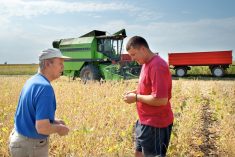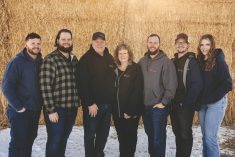Editor’s Note: Bonnie Whitehead, M.Sc. (psychology) launches her new CG column demonstrating how the rapidly evolving science of psychology can improve your business and personal farm success. She begins with generativity and its exciting opportunity to keep us strong and vibrant as we age.
Our motivation to achieve is deeply embedded in our personalities. The desire for accomplishment and competence is not just a spinoff of youthful vitality; it will be present right into later years of life.
This is worth careful consideration, perhaps especially for high achievers. Aging is a heterogenous process. There is no stereotypical way everyone ages. The choices an individual makes in midlife in realms including their health, socialization and career affect their satisfaction and biological vitality as they age.
Read Also

Youth motivated to find answers to today’s agricultural challenges
This is the first in a series of articles exploring the perspectives and experiences of young people who are finding…
Two things stand out: First, human development is lifelong. It is important to appreciate and prepare for the fact that we will need to achieve and maintain competency into old age. Second, because the ways we approach life and decision-making affect our well-being and health, we must choose well.
So what should adults aim at to increase the probability of life satisfaction and health as they age?
Generativity vs. stagnation: The essential challenge of adulthood
Famous psychologist Erik Erikson suggested that certain psychological and social achievements are necessary across the lifecourse for healthy aging. To Erikson, the conflict between generativity and stagnation is the essential challenge of adulthood.
Generativity is the capacity and extent to which adults nurture. It is relevant to any work that positively affects the future, including but not limited to work in family, occupational and professional domains.
Generativity is intimately related to the social life and relationship development capacitities of adults. Indeed, emotional intimacy (mutuality, sharing, connectivity, good will, love) with a significant other (spouse, partner) sets the stage for generativity and shares important characteristics with it. Whereas intimacy is an expression of connection and care towards one person, however, generativity is a broadening and turning outward of intimacy towards showing care and good will to society, family and community generally (Carver & Scheier, 2012).
Cognitive, emotional and physical effects of generativity
Research shows evidence of positive effects of generativity across multiple domains of function for older adults, including but not limited to boosts in cognitive functioning, emotional well-being and physical health.
Strong, positive social connections likely protect generative adults from aging-related decline in cognitive function. Maher and colleagues (2017) define SuperAgers as persons over 80 years old with memory capabilities for events which are equal to or better than that expected for people between 20 to 30 years younger.
Memories of recent events (i.e. episodic memories, as compared to memory for facts and dates) are critically affected early on in neurological disease associated with aging (e.g. Alzheimer’s disease; Maher et al., 2017). SuperAger’s excellent memory capabilities align with better-than-average neurological integrity right into old age.
What may explain SuperAger’s superior neurological health and cognitive performance?
Maher and colleagues (2017) show evidence that individuals with good emotional well-being tend to have higher cognitive functioning as they age. SuperAgers have high well-being, which the research shows is attributable to their strong, positive relationships. The presence and nature of these relationships are significantly associated with the better-than-expected cognitive functioning and neurological integrity in SuperAgers in old age (Maher et al. 2017).
Within the realm of physical vitality and health, research following older adults over a 10-year period showed that older adults with higher levels of generativity were less likely to pass away or incur a disability that affected their activities of daily living (Gruenewald, Liao, & Seeman, 2012).
Interestingly, it doesn’t take years to garner effects from generativity on health status: Older adults engaging in generative activities show a corresponding drop in inflammatory markers and increases in well-being over as little as six weeks (Moieni, 2020).
Being generative. Where to start?
There are four essential acts of generativity: To desire, to give birth to, to accompany, and finally, to let go (Becchetti & Bellucci, 2020). An important point stands out here. It makes sense for individuals to continue their generative journey from where they are presently at.
Do you desire to give back to your community? It may be time to give birth to a special project relevant to the present needs of your community. Have you nurtured a project or business and now feel it’s time to let go? Perhaps you ought to think about your desires again.
Generativity is accomplished in many ways, and in many domains. In professional life, generativity may come from creating organizations, passing family-run corporations on to the next generation, writing books, and contributing to professional boards and organizations in a way that helps mobilize, stabilize and strengthen future work within the profession, for example.
In civic realms, contributing to programs or projects that enhance critical community capacities are examples of means by which individuals live generative lives.
In family realms, child rearing and having a positive impact on grandchildren contribute to generativity. In fact, effects of generativity on cognitive function have been documented in grandparents who babysit grandchildren: Rate of decline in memory function is associated with hours of grandparent caregiving, with grandparents engaged in babysitting showing better resiliency to memory decline with age (Sneed & Shultz, 2019).
Generativity: The building block of resiliency and well-being in old age
Generativity is the substance that forms one’s sense of satisfaction with life in old age. An example from horseback riding is pertinent. Reining is often described as western dressage. The pinnacle move of a reining pattern is the sliding stop. There are two anomalies about the sliding stop. The first is that it rubs philosophically that a “stop” could be a pinnacle move: Stops usually come in life after all the excitement has been had. The second anomaly about the sliding stop is the process of achieving one. Horseback riders accelerate as hard as possible, hands forward, reins draped, urging the horse to accelerate right until the moment of cueing for the stop.
When that moment comes, the horse’s powerhouse rump and leg muscles are already engaged to power the acceleration. The stop then isn’t a total change in course: the horse’s legs, extended far under the animal’s body, and hooves gripping hard, are in the perfect spot for a dust-billowing, sliding stop.
That’s a lot like generativity in adulthood, and how it transforms itself into satisfaction in old age, even in the face of loss.
Generative adults grip hard by investing skills and abilities in a way that will create positive impact beyond their lifetimes. And when it’s time to stop, they are hopefully and expectantly positioned for a glorious sliding one. They aim well, so that retirement can be their pinnacle move of a lifetime, while simultaneously giving themselves the best chances of retiring with well-being, strong relationships and health.















